Offshore wind energy - draft sectoral marine plan: regional locational guidance
Regional locational guidance (RLG) prepared for the draft sectoral marine plan for offshore wind energy.
3 South West
3.1 Introduction
3.1.1 The South West region extends northwards from the Scotland-England border, incorporating the Solway Firth, the North Channel and the southern tips of the Mull of Kintyre and the Isle of Arran (Figure 54). There is one DPOs identified within the South West region, adjacent to Luce Bay, in addition to current offshore wind development in the area, focussed in the Solway Firth.
Figure 54 Map of the South West region including DPOs
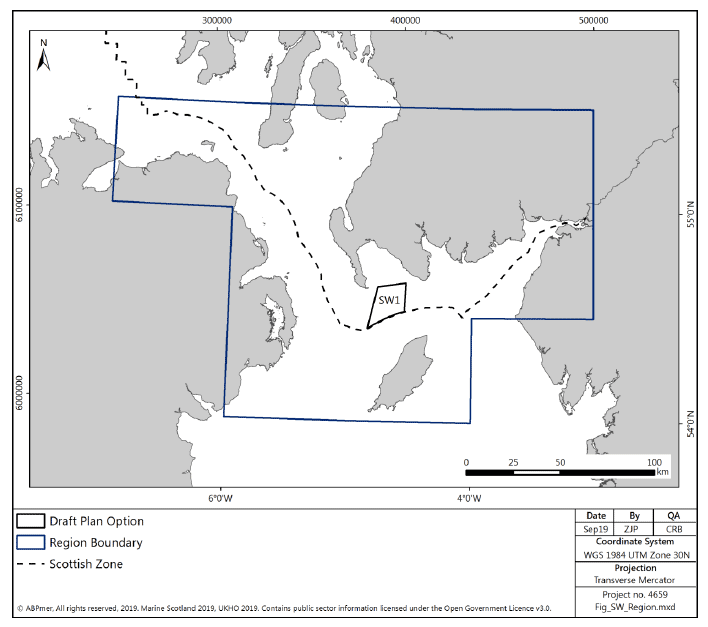
3.2 Physical Considerations
Offshore Wind Resource
3.2.1 Within the South West region, encompassing one DPO (SW1), there is available resource, some of which is being exploited by development within the Solway Firth. There is less resource available when compared to the more exposed regions, particularly the West and North as shown in Figure 55 using the mean annual wind speed as a proxy, and shown in Table 2.
Figure 55 South West region: mean annual wind speed
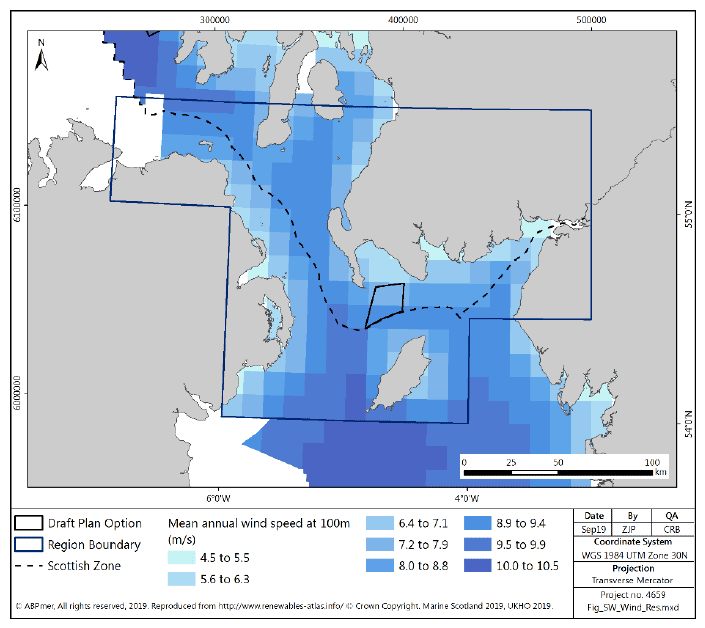
Table 2 South West region: Potential installed capacity in the DPO
| Area of Search | Region | Area (square km) | Potential Installed capacity (GW)[161] |
|---|---|---|---|
| SW1 | South West | 292 | 1.5 |
| South West Total | 292 | 1.5 | |
Grid Connection
3.2.2 The grid provision in the South West region is predominantly linked into 132kv substations, however there are areas of higher capacity, particularly associated with the Moyle Interconnector (275kv) and the transmission south across the border close to the upper reaches of the Solway Firth.
Bathymetry and Seabed
3.2.3 The water depth in the South West region ranges from shallow water (less than 60 m) in extensive areas within the Solway Firth and towards the Firth of Clyde, but shelves sharply to greater than 100 m in the North Channel (Figure 56). SW1 lies within the 0-60m depth contours.
3.2.4 Seabed sediments are principally mud in areas within the Firth of Clyde, to the east of the Mull of Kintyre, and towards the inner Solway Firth. In areas where the water depth is greater, the sediments are principally sand, or sand and gravel, including throughout the North Channel, to the south and west of the Mull of Kintyre, and in the outer Solway Firth (Figure 57). SW1 overlaps substrates that include sandy gravel and gravel, sand and silt and muddy sandy gravel.
Figure 56 South West region: banded water depth
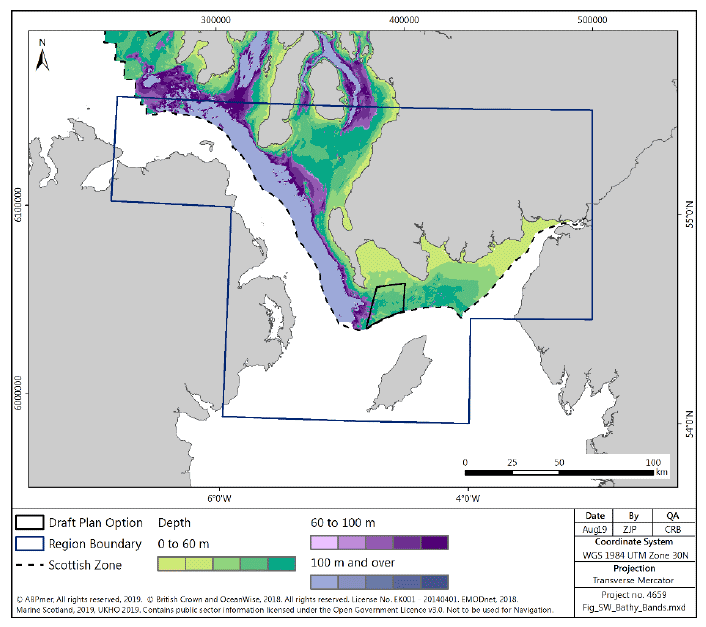
Figure 57 South West region: seabed sediments
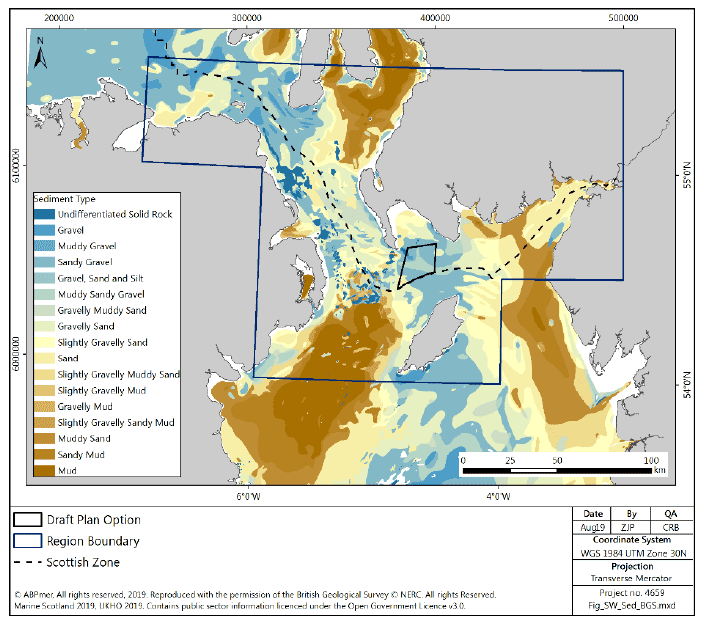
3.3 Socio Economics
Supply Chain
3.3.1 There is one area currently identified at the northern edge of the South West region[162] which could be developed to support the construction, operation and maintenance of offshore wind in the DPO. This is Campbeltown / Machrihanish, on the Mull of Kintyre, which is identified as having potential to support further maintenance and operation / maintenance and was engaged to manufacture of towers for the Beatrice offshore wind farm, producing up to 200 towers between 2017 and 2019.[163]
3.3.2 The development of the Robin Rigg array in the Solway Firth, was identified as having 11% Scottish content, of which 0.2% was attributed to the local council area, Dumfries and Galloway.[164] The array was identified as having approximately 26% content from other UK regions, including North-west England, and Wales
3.3.3 There is potential for further development within the South West region to utilise supply chains present in other regions, or south of the border in England or Wales.
Energy Generation
3.3.4 There is one offshore wind farm currently operational in the South West region, Robin Rigg in the Solway Firth (180MW) which has been fully operational since 2010 (Figure 58). This does not overlap with the proposed SW1.
3.3.5 Tidal stream energy generation is currently being developed within the South West region, there are two draft plan option areas within the region and there are two agreements for lease issued by Crown Estate Scotland for proposed tidal stream installations (Figure 58):
- Mull of Kintyre; and
- Solway Firth.
3.3.6 Neither of the sites is currently operational, and neither has applied for, or been granted, consent to date.
3.3.7 One of these proposed Tidal DPOs overlaps with SW1.
Figure 58 South West region: current, planned and potential future offshore energy generation infrastructure
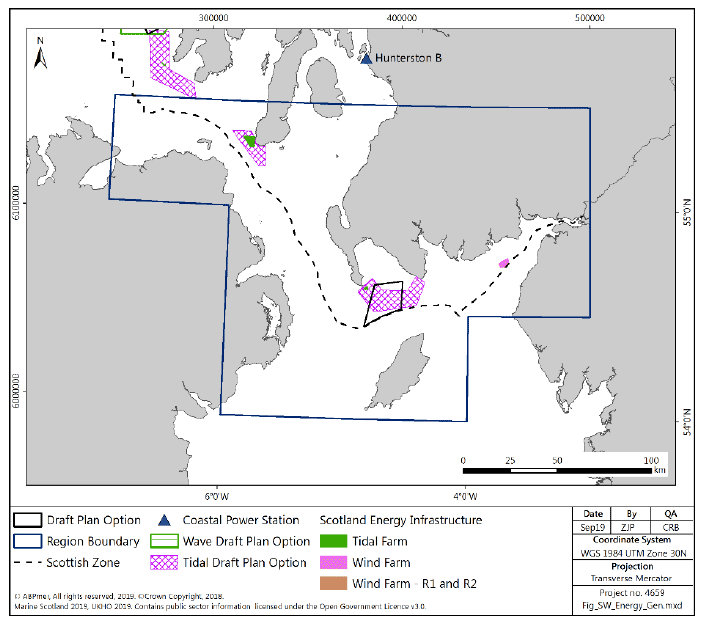
Power Interconnectors
3.3.8 There are 140km of power interconnectors in Scottish waters in the South West region, connecting Scotland to Northern Ireland (HVDC Moyle interconnector) and England (Western HVDC link) (Figure 59). None of these interconnectors intersect or lie in the vicinity of SW1.
Figure 59 South West region: power interconnectors
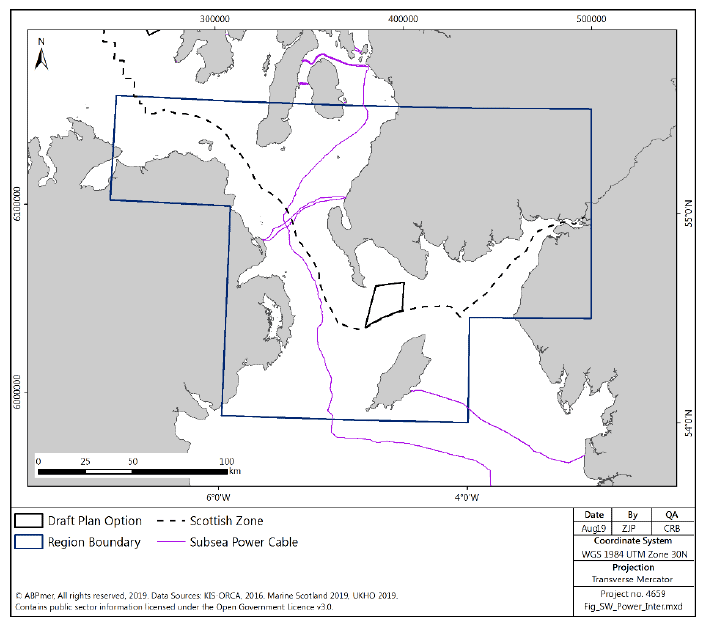
Telecom Cables
3.3.9 There are 341km of active telecom cables in Scottish waters in the South West region, principally connecting mainland UK to Northern Ireland (Figure 60). The majority of these cables originate from the Firth of Clyde, with some additional cables running through the North Channel. There are no telecom cables within the Solway Firth. None of these telecom cables intersect or lie in the vicinity of SW1.
Figure 60 South West region: active telecom cables
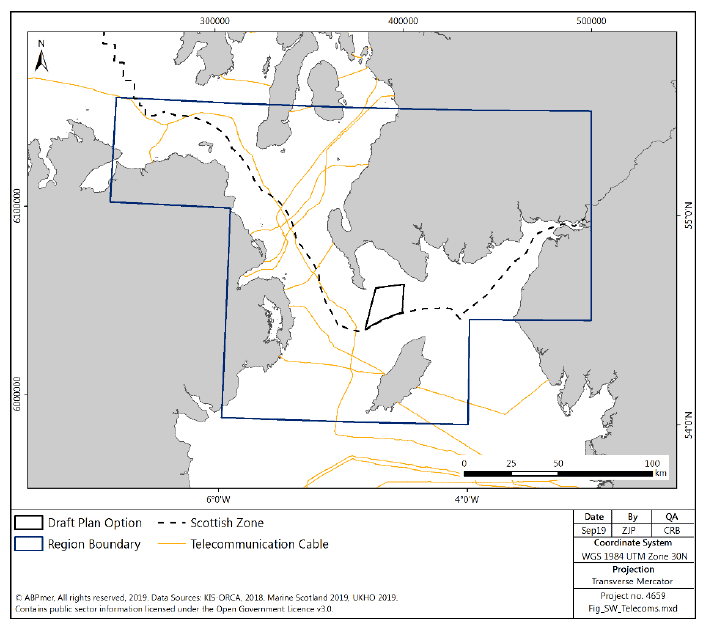
Carbon Capture and Storage
3.3.10 There are currently no identified potential CCS storage areas on the west coast of Scotland. All potential saline aquifers, and most of the oil and gas infrastructure, are off the East coast.
Oil and Gas
3.3.11 There are very few oil and gas related activities currently taking place within this Region. There are three pipelines, connecting mainland Scotland to Northern Ireland and Ireland (Figure 61). The potential for future exploration and development in the South West region is low. One of the pipelines lies close to the proposed SW1 site but does not intersect the DPO.
Figure 61 South West region: oil and gas infrastructure
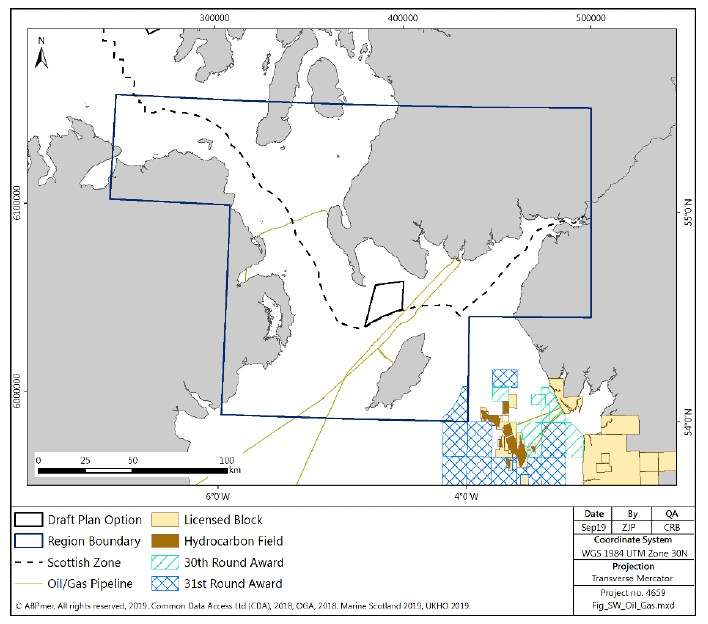
Aviation
3.3.12 There are no major airports, and one minor airport (Campbeltown) in the South West region, with patchy radar coverage, limited to areas covering the Solway Firth (Figure 62). However, there is some overlap between primary surveillance radar coverage at 200m and SW1.
Figure 62 South West region: aviation infrastructure and radar coverage
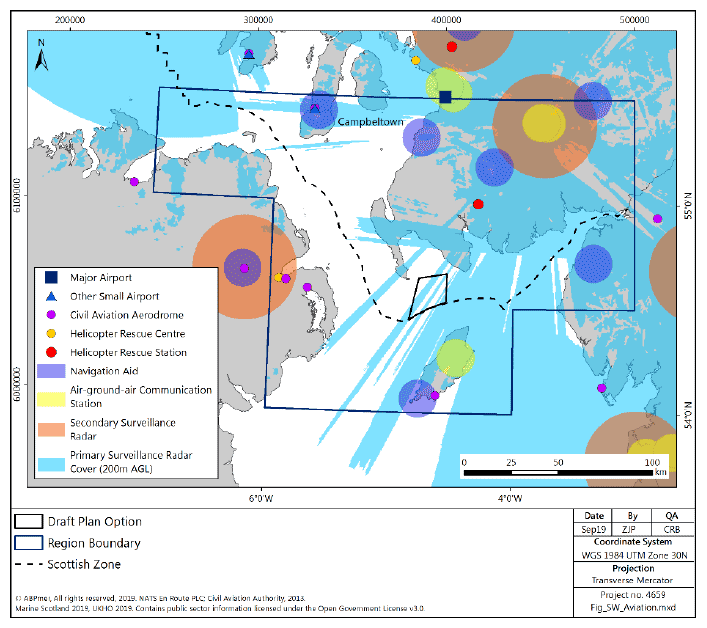
Defence
3.3.13 There are several defence sites within the South West region. The largest establishment is MOD West Freugh, used as a firing range for testing and evaluation and training. The range includes air, sea and land danger areas. The sea danger area is approximately 380km² (Figure 63). The facility supports direct employment of 30 staff,[165] and is likely to support additional indirect employment in the region.
3.3.14 There is a significant historic munitions disposal site in the South West region, centred on Beaufort's Dyke (Figure 63). Beaufort's Dyke is an area of deep water, just off the coast of the Rhins of Galloway, used by the MOD and its predecessor organisation, the War Office, to dispose of conventional, incendiary and chemical weapons. Up to a million tonnes of munitions were disposed of, the majority of which are within the Dyke itself, however there are known to be munitions on the seabed surrounding the dyke, outside of the official boundaries of the dump site.[166] In 1995 a significant number of munitions were discovered on beaches in the area, coinciding and potentially linked to the laying of a submarine gas pipeline linking Scotland and Northern Ireland.[167]
3.3.15 Of particular relevance to SW1 is the MOD West Freugh, which lies immediately to the north and the Naval exercise area which overlaps with the southwest corner of SW1. Additionally, whilst not adjoined, Beaufort's Dyke lies close to the west of SW1 (Figure 63).
Figure 63 South West region: defence infrastructure and exercise areas
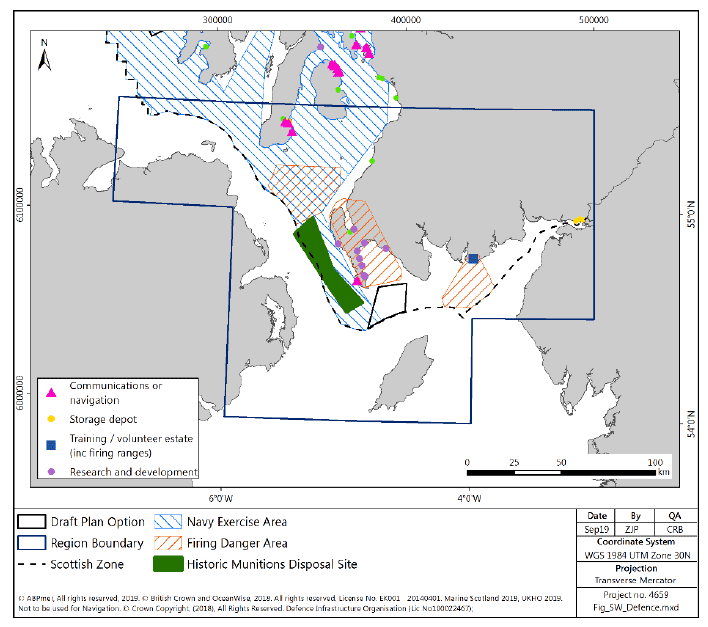
Fishing
3.3.16 Landings from UK-registered vessels from ICES rectangles in the South West region had an average annual value of £173 million and an average live weight of 19,272,898 tonnes for the five-year period 2013-2017.
3.3.17 The majority of landings were shellfish (92%) with the majority of landings by over 12 m vessels (74%).
3.3.18 Figure 64 shows over-15m Nephrops trawlers work in the Clyde, towards the north of the region, and in Northern Irish waters to the south-west of the region. Scallop dredgers work from Kintyre to the Northern Ireland coast, as well as around the Rhins of Galloway and Luce Bay. Demersal fish trawlers operate in the deep water of the North Channel off the Rhins of Galloway. Herring is fished in some areas, particularly to the south of the Rhins of Galloway, across to Northern Ireland and the Isle of Man (Figure 65). Over-15m vessels using static gear to target Nephrops are focussed in the outer Firth of Clyde. Those targeting lobster are predominantly in the outer Solway Firth and north of the Isle of Man (Figure 66).
3.3.19 Areas important for under-15m vessels are predominantly inshore. Nephrops trawlers work mostly in the north of the region in the Firth of Clyde. There is some scallop dredging, with low numbers of vessels operating in the outer Firth of Clyde and around the Rhins of Galloway and Luce Bay (Figure 67). There are low levels of Nephrops and crab/lobster creelers in the region, with crab/lobster creels focussed inshore around the Rhins of Galloway (Figure 68).
3.3.20 There were 179 fishing vessels with their Home Port registered within the South West region in 2016.[168] The majority (56%) of these were in the ten metres and under length category. The ports with the most registered vessels were Campbeltown (77), Ayr (62), Kirkcudbright (17), Annan (4) and Ballantrae (4). Home ports within the South West region are shown in Figure 69.
3.3.21 Of particular relevance to the SW1 site, are the scallop dredging grounds, lobster creeling and herring grounds (pelagic trawling).
Figure 64 Fishing intensity for over-15m vessels in the South West region using demersal mobile gear (2009-2013)
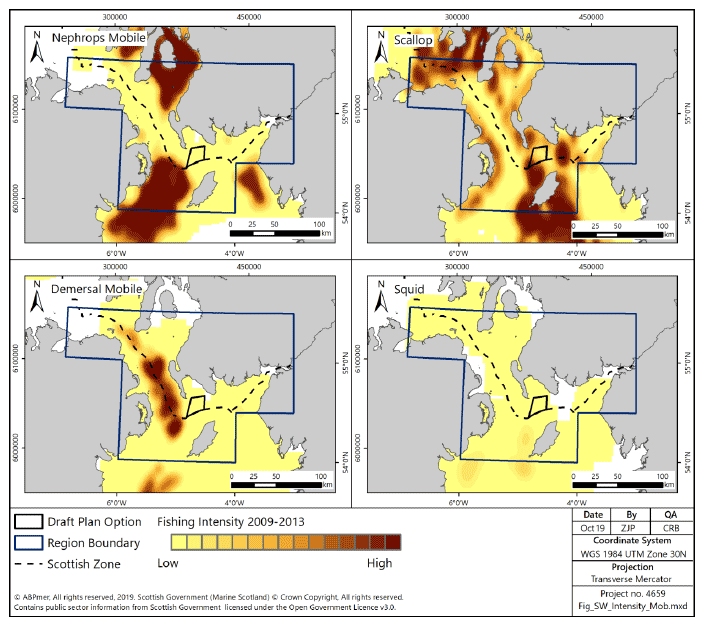
Figure 65 Fishing intensity for over-15m vessels in the South West region targeting pelagic species (2009-2013)
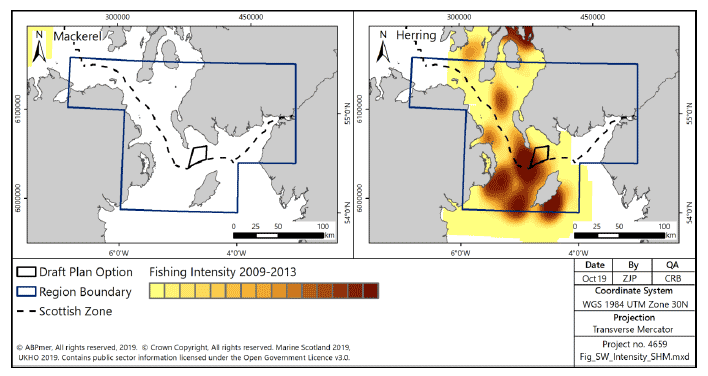
Figure 66 Fishing intensity for over-15m vessels in the South West region using static gear (2009-2013)
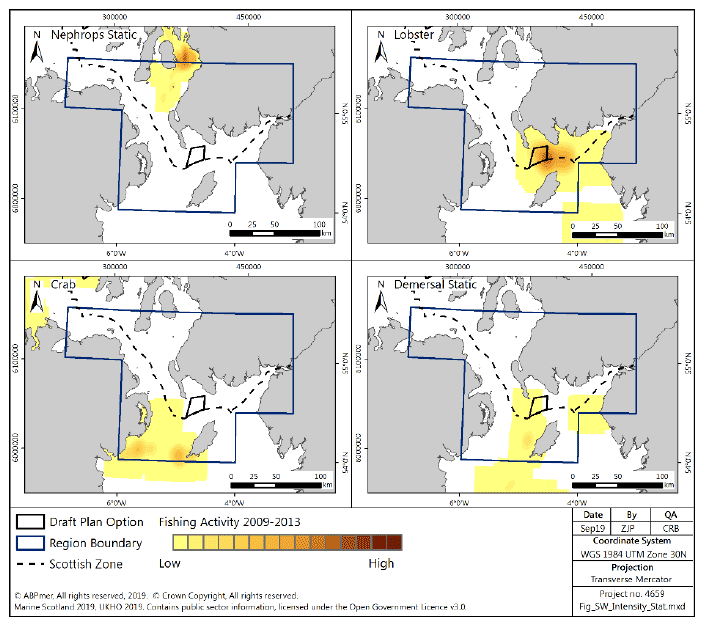
Figure 67 Number of vessels for under-15m vessels in the South West region, all gears and mobile demersal gears, from ScotMap
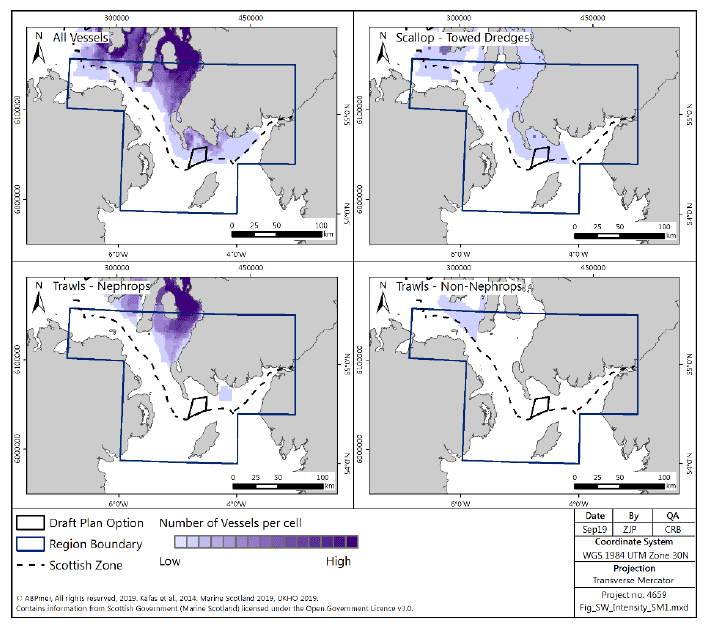
Figure 68 Number of vessels for under-15m vessels in the South West region, pots, divers and mackerel lines, from ScotMap
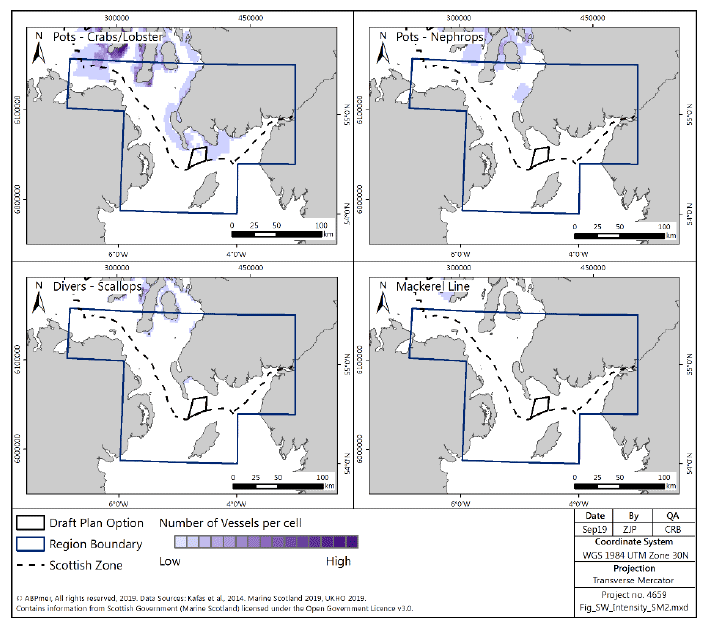
Figure 69 South West region: distribution of home ports
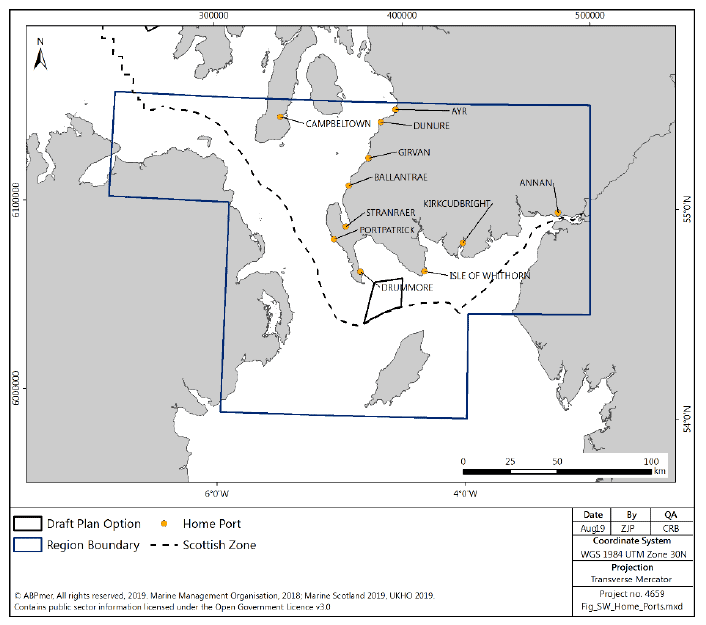
3.3.22 The main landing ports (in terms of value of landings in 2016) in the South West region were Kirkcudbright (£4.8 million), Campbeltown (£4.0 million) and Girvan (£1.0 million).[169]
3.3.23 In the period 2011-2016 there were 16 fixed engine netting sites in the South West region for wild salmon and sea trout, and two net and coble sites (Figure 70).
3.3.24 The main rod and line fishing rivers in this region are the Border Esk, Annan, Nith, Urr, Cree and Bladnoch.[170]
Figure 70 Salmon and sea trout net fisheries reporting catches in 2011-2016 in the South West region
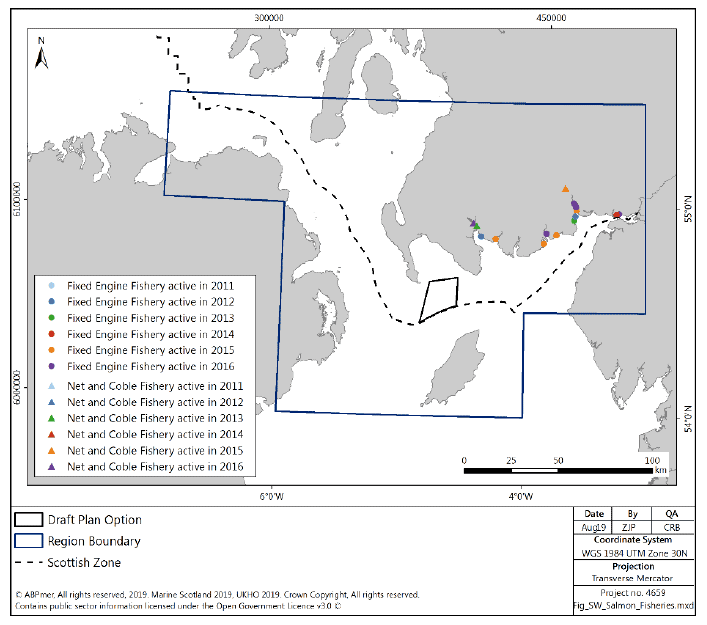
Aquaculture
3.3.25 Marine aquaculture sites within the South West region are shown in Figure 71. There are two licensed shellfish sites and one licensed finfish site. One shellfish site and one finfish site are at the northern boundary of the South West region, on the Mull of Kintyre, with a further shellfish site to the north of the Rhins of Galloway in Loch Ryan.
3.3.26 There is no available breakdown of production that can be used to establish production volumes, value or employment for the South West region, however it is likely to be low when compared to other regions, particularly the West, North and Shetland regions where the number of sites is much greater.
Figure 71 South West region: marine aquaculture sites
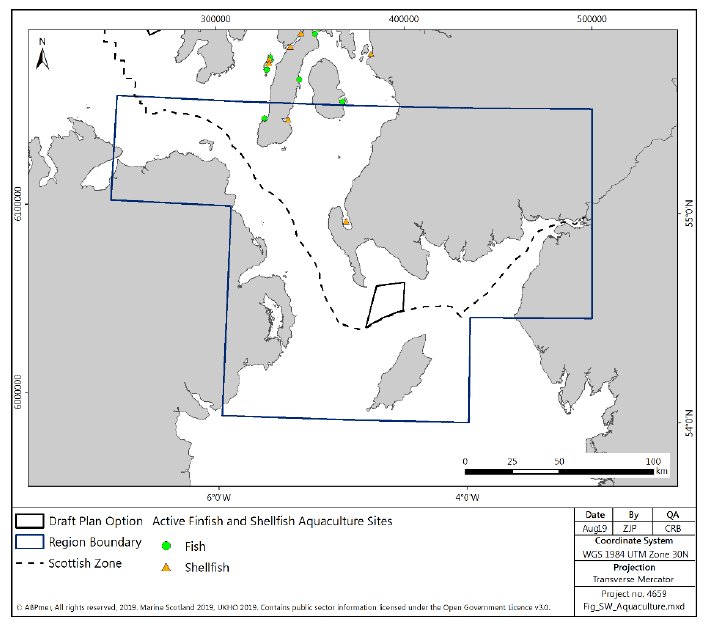
Ports and Harbours
3.3.27 Figure 72 shows that there are 2 major ports, 4 minor ports and numerous smaller harbours and marinas supporting commercial and recreational fishing activities, yachting and recreation throughout the South West region.
3.3.28 Cairnryan is principally used as the port of departure for ferry services to Larne in Northern Ireland. The route is the shortest and fastest commercial ferry crossing between Great Britain and Northern Ireland with up to 16 scheduled ferries daily.[171] Stranraer was historically used as a ferry port, however with the transfer of services to Cairnryan it is used as a fishing harbour and for recreational purposes. However, these ports are not in the vicinity of SW1, rather, Port William and Drummore harbours are closer to the site, albeit attracting lower levels of vessel traffic.
Figure 72 South West region: ports and harbours
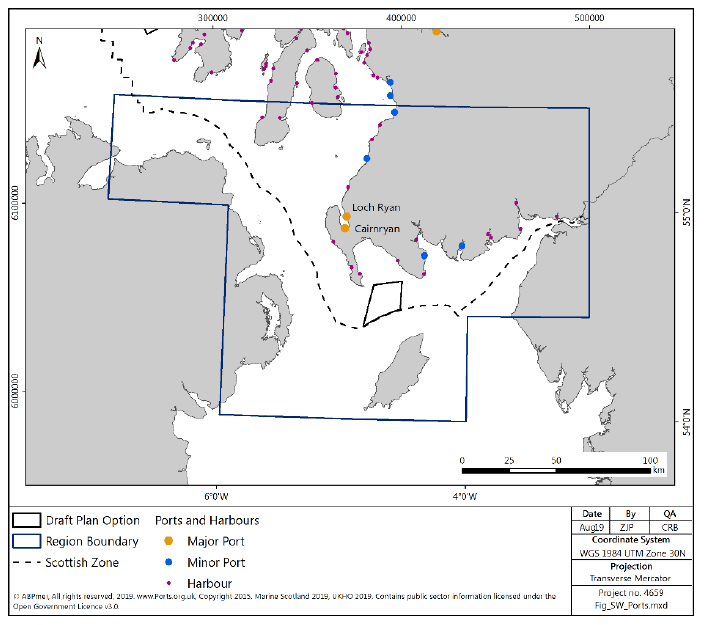
Shipping
3.3.29 Areas of sea within the South West region include key shipping routes with areas of very high density traffic (Figure 73). To the north of the region this includes routes transiting to the Firth of Clyde, whilst to the west the key routes with highest density are those through the North Channel, including the North Channel TSS.
3.3.30 There are a number of ferry routes which transit through the North Channel and link Scotland to Northern Ireland, particularly from Cairnryan (discussed above).
3.3.31 There is an overlap between SW1 and one of the main transit routes through the region. In addition, Figure 73 shows that port service craft and passenger vessels utilise the area overlapping the site SW1.
Figure 73 South West region: shipping densities and key routes
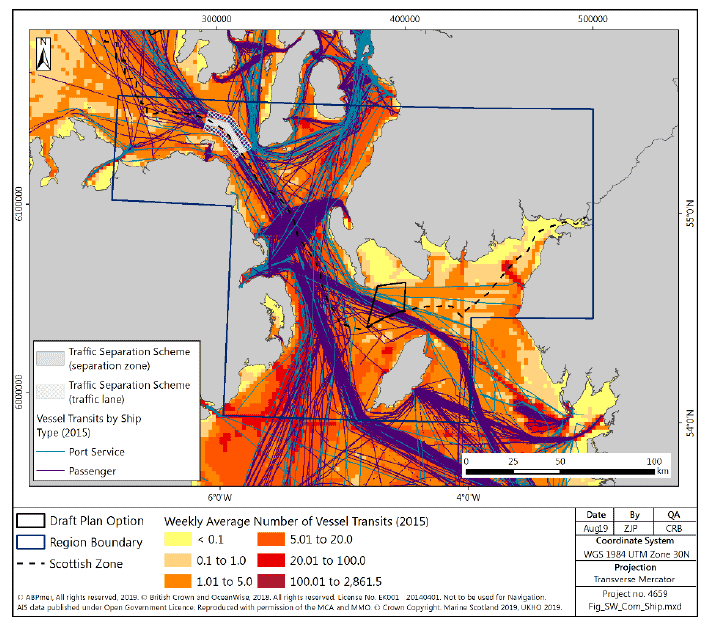
Coastal and Flood Protection
3.3.32 There are relatively few coastal or flood protection shorelines in the region. However, there are areas of hard defences in Loch Ryan, and areas of hard defences associated with port and harbour facilities (Figure 74).
3.3.33 The coastline closest to the SW1 site (Mull of Galloway) is characterised by a mixture of coastline types, including rocks/ hard cliffs (low erosion), soft coastline (which are subject to erosion) and natural beaches). Those coastlines found in Luce Bay are characterised by soft coastline and natural beaches but are located >5km away from site SW1.
Figure 74 South West region: coastal and flood protection schemes
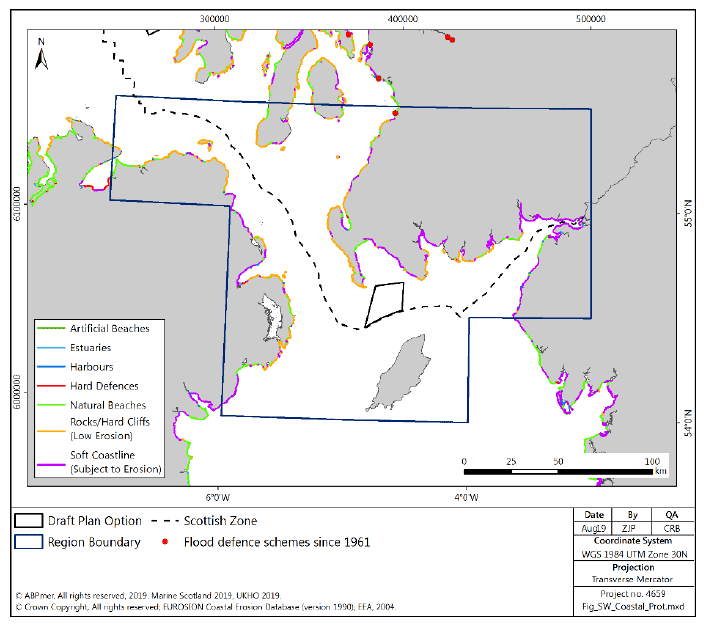
Marine and Coastal Recreation
3.3.34 Overall recreational activity in the South West region is shown in Figure 75. There is relatively low activity throughout the region, with the majority of activity either in close proximity to the coastline or towards the northern edge of the region, towards the entrance to the Firth of Clyde.
3.3.35 With the exception of recreational angling, discussed below, there is considered to be a low-level of recreational activities conducted in the area in or around SW1.
Figure 75 South West region: density of recreational activities
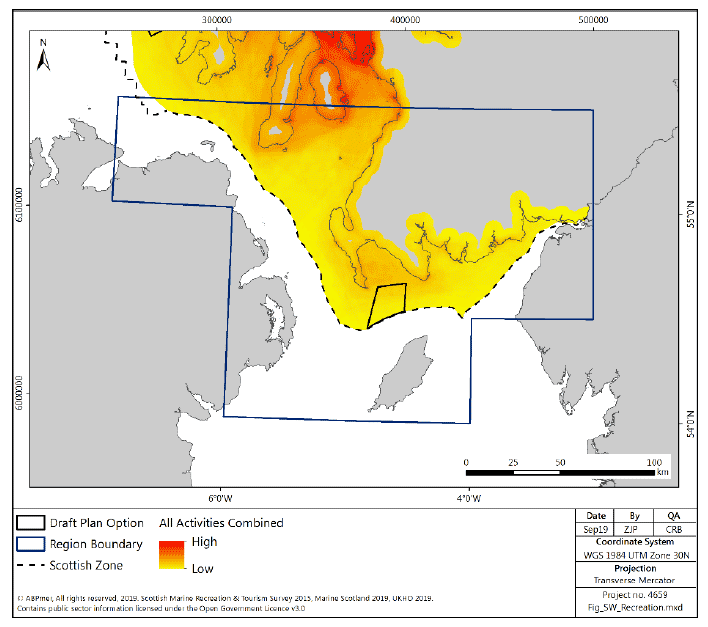
Boating
3.3.36 The west coast of Scotland is well known for sailing, although the majority of the activity is concentrated in the West and North regions, with lower concentrations of activity in the Solway Firth (Figure 76).
3.3.37 There is some activity associated with routes from Belfast in Northern Ireland, including routes north through the North Channel and across the North Channel to the Rhins of Galloway. There are a small number of RYA facilities, including marinas, clubs and training centres in the South West region, principally in the Solway Firth.
3.3.38 Figure 76 shows that there is a low - medium density of AIS transits occurring in the area overlapping SW1.
Figure 76 South West region: recreational boating facilities and recreational boating density (from 2015 AIS data)
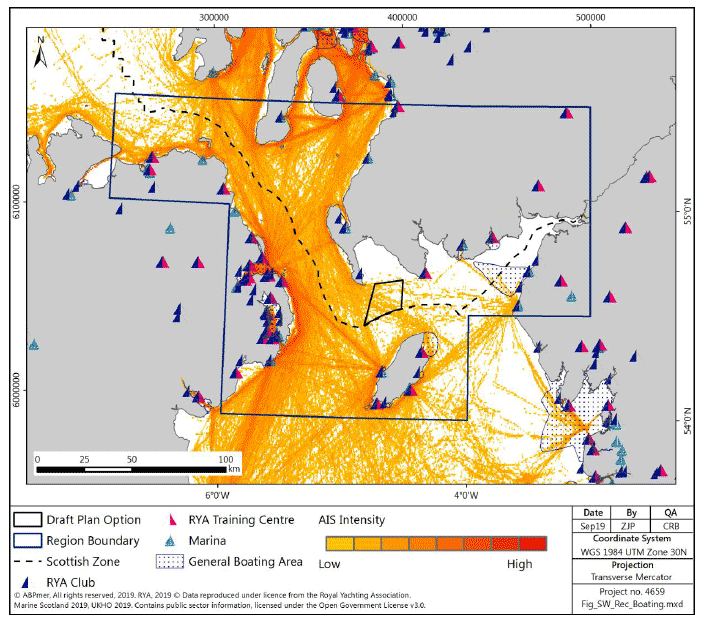
Angling
3.3.39 There is a high concentration of sea angling activity within the South West region. This is concentrated in the outer Solway Firth and to the west of the Rhins of Galloway. There is further activity along the coastline in the north towards the Firth of Clyde (Figure 77).
3.3.40 There is a high-level of overlap between SW1 and angling activities shown in Figure 77. The main angling fisheries in the area target tope, mackerel, herring and thornback ray.
Figure 77 South West region: sea angling (by boat) activity density
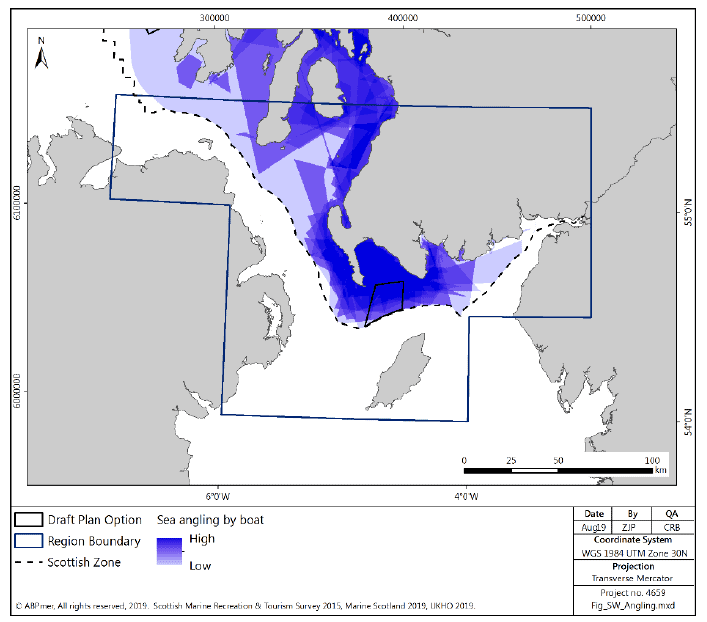
Scuba Diving
3.3.41 The South West region is the least popular region for scuba diving. There is a high concentration of scuba activity that takes place on the south coast of the Isle of Arran in the Firth of Clyde and the Isle of Whithorn (approximately 5km to the north-east of SW1). There is a lower level of activity that takes place around Campbeltown and Southend, with most of the coastline having no significant scuba diving activity (Figure 78).
3.3.42 There is some overlap between scuba diving activity recorded at the northern boundary and SW1.
Figure 78 South West region: scuba diving activity density
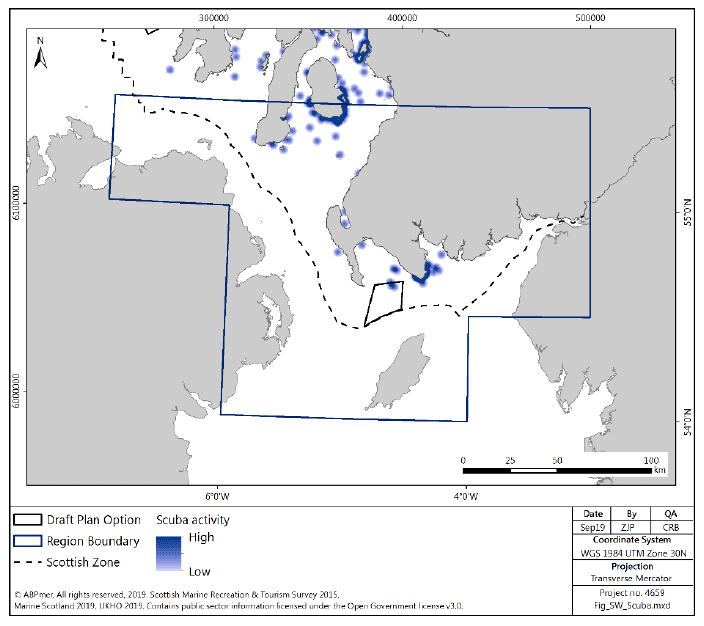
Kayaking and canoeing
3.3.43 Kayaking and canoeing takes place at most locations around the south west coast where there are suitable launching spots such as beaches and slipways. The majority of trips are close inshore or short distances between headlands (Figure 79).
3.3.44 Kayaking and canoeing are conducted close to SW1 and around the coastline of Luce Bay, particularly around the Mull of Galloway.
Figure 79 South West region: canoeing or kayaking activity density
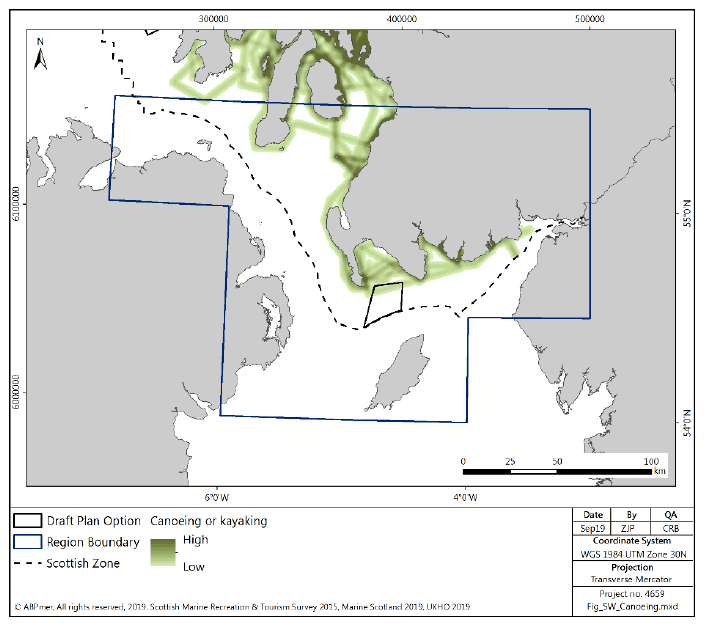
Surfing and Windsurfing
3.3.45 There is a very low level of surfing and windsurfing activity that takes place in the South West region (Figure 80). Available data indicate that there is may be some overlap with these activities and SW1, albeit at low levels.
Figure 80 South West region: surfing, surf kayaking and paddleboarding activity density
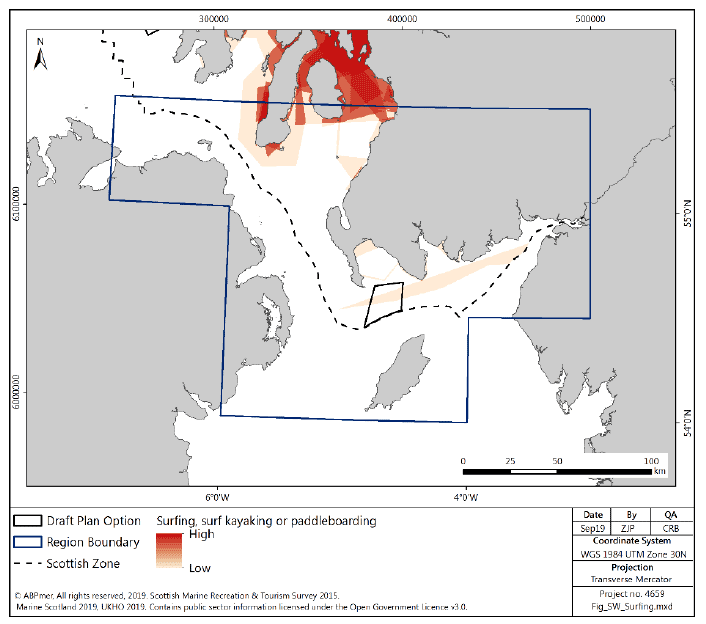
Tourism
3.3.46 The South West region has a range of tourist destinations throughout the region. The highest levels of visitors are seen along the coast (Figure 81). In 2017, 56% of visitors came to the region on holiday.
3.3.47 The South West region contains a wide range of different landscapes which are of substantial economic value to the region because they bring tourists to the area. The region also has the Nith Estuary, Fleet Valley and the East Stewarty Coast which are designated as National Scenic Areas. The top attractions in the region include; the Gretna Green Blacksmith shop, Galloway Forest Park, Mabie Farm Park and Theave Garden.[172] There is a moderate to high concentration of tourism activity on the Mull of Galloway, from which development in SW1 may be visible.
Figure 81 South West region: tourism activity density
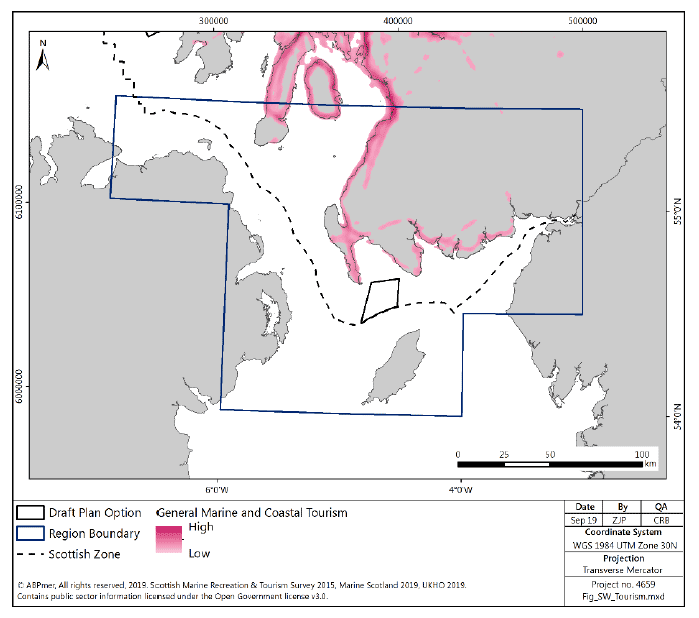
Social Considerations
3.3.48 The Dumfries and Galloway Council areas have been used to obtain approximate values for the South West region. The total population of the South West region is approximately 262,000. The average age in the region is 47.5, which is 6.5 years greater than the national average of 41 years old. Roughly 16% of the population is under 16 years old, 57% are of working age and 27% of pensionable age.
3.3.49 In 2017 the employment rate was 92.8%, down from the previous year at 94.5%. The greatest number of jobs in the South West region are associated with public admin, education and health (31.6%). Other important industry sectors are distribution, hotels and restaurants (19.5%) and banking, finance and insurance (12.3%).
3.4 Environment
Designated Sites
3.4.1 Within the South West region, there are several designated sites and sites proposed for designation in the future, including SPA, SAC, Ramsar, NCMPA, and SSSI. These sites are designated for a range of features considered important on an international or national level.
3.4.2 Sites within the region include 4 SPA (including 2 pSPA), 2 SAC, 2 NCMPA and 9 SSSI, shown in Figure 82, Figure 83, Figure 84 and Figure 85.
3.4.3 SW1 adjoins Luce Bay and Sands SAC but does not intersect any other designated site. The site is designated for features including reefs and whilst these have not been designated within the SW1 site, they have the potential to extend out to the DPO.
3.4.4 In addition to the sites identified within the boundaries of the South West region, there may be more remote designated sites which may have the potential to be affected by offshore wind development within the DPOs. This would be considered on a project by project basis.
Figure 82 South West region: NCMPA sites
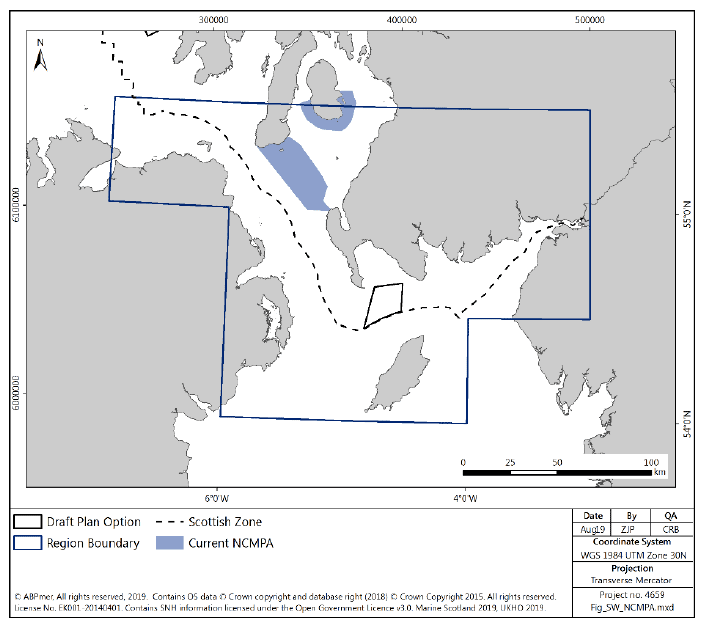
Figure 83 South West region: marine and coastal SAC sites
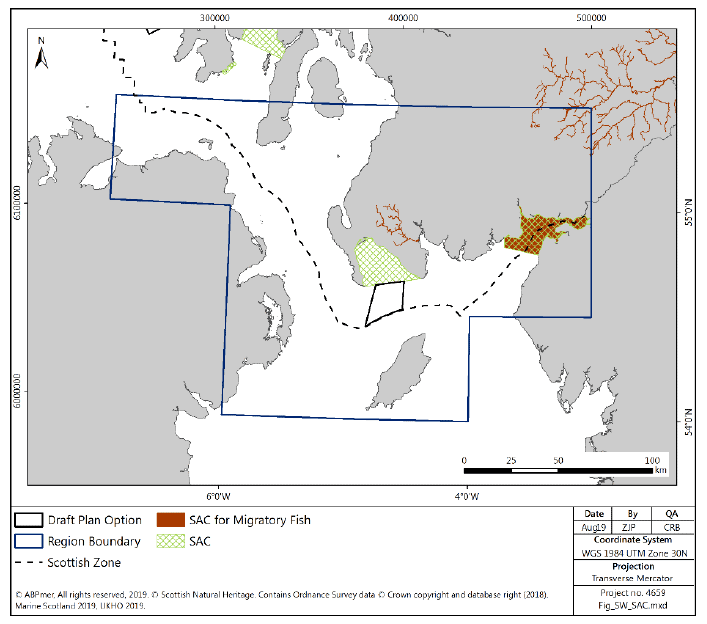
Figure 84 South West region: marine and coastal SSSI sites
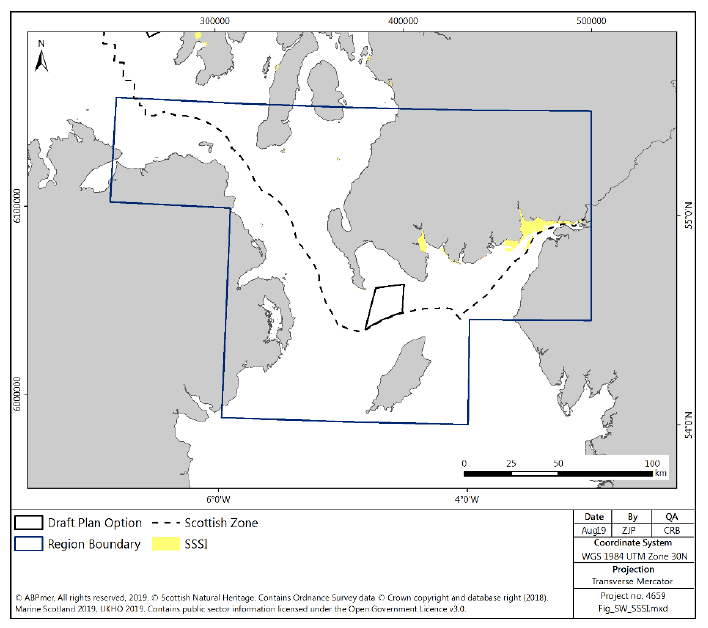
Figure 85 South West region: marine and coastal SPA sites
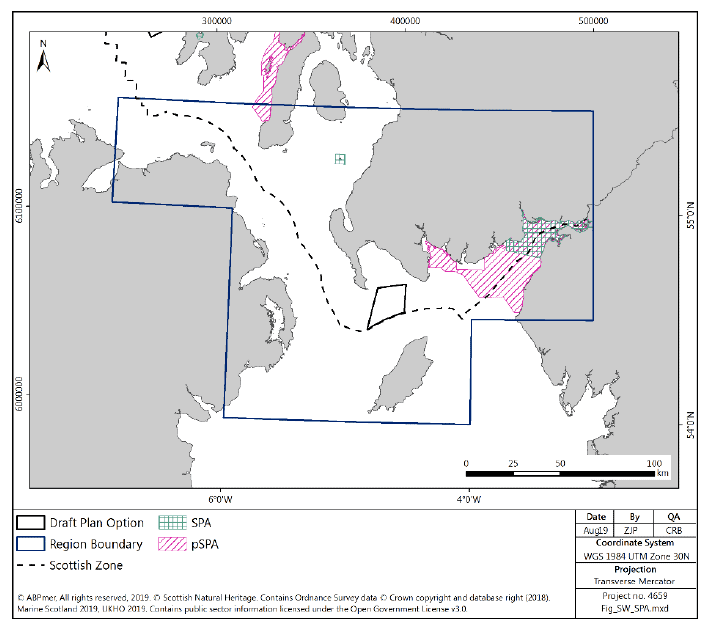
Water Quality
3.4.5 WFD monitoring incorporates coastal and transitional waters in the marine environment. There are 27 water bodies within the South West region, 33 of which are at High or Good status. There is one site at moderate status and three noted as having good ecological potential (Figure 86). SW1 overlaps with the Luce Bay water body, currently assessed as being at Good status.
3.4.6 There are no protected waters for shellfish production in the South West region.
3.4.7 There are 14 classified bathing waters in the South West region (Figure 87). Of these 6 are at poor status, with the remainder either meeting target objectives, or at good or excellent status.
Figure 86 South West region: WFD coastal and transitional waterbody classifications
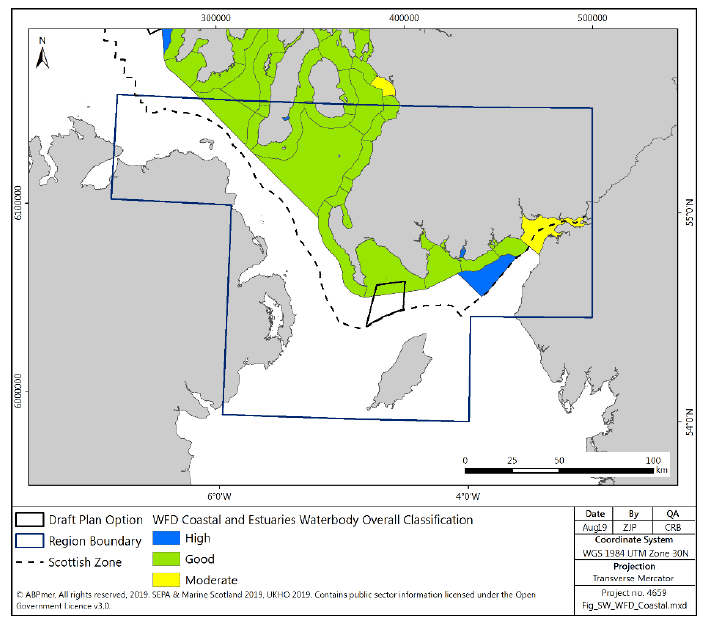
Figure 87 South West region: shellfish and bathing water protected areas
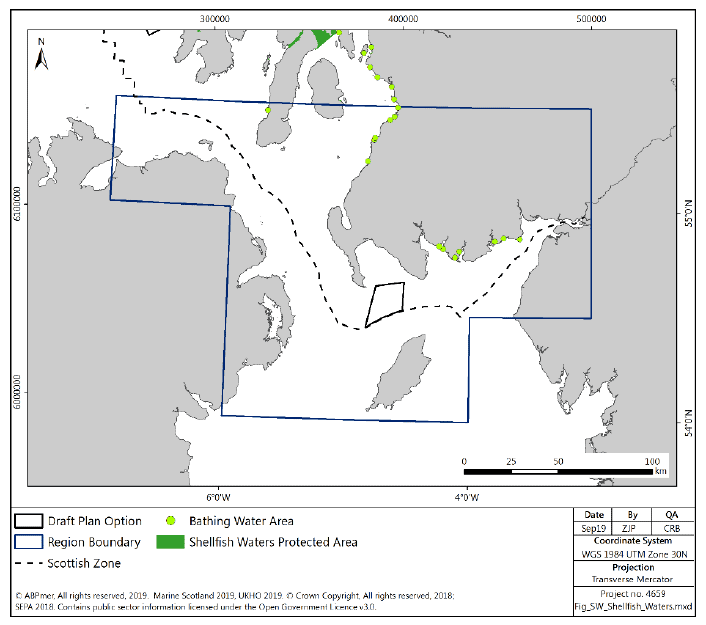
Benthic Habitats and Species
3.4.8 As identified in Section 3.2 above, the majority of the benthic sediment is characterised by mud in the shallower regions, within the Firth of Clyde and the inner Solway Firth. As water depth increases this gradates to sand and gravel sediments (Figure 88). The substrate that overlaps the DPO is characterised by infralittoral mixed sediment and circalittoral mixed sediments.
3.4.9 There are a number of records of benthic PMFs throughout the South West region, including kelp and seaweed species, fan mussel (Atrina fragilis), maerl (Phymatolithon calcareum), seagrass species, burrowed mud, tall sea pens (Funiculina quadrangularis), native oyster (Ostrea edulis) and blue mussel (Mytilus edulis).
Figure 88 South West region: benthic habitats
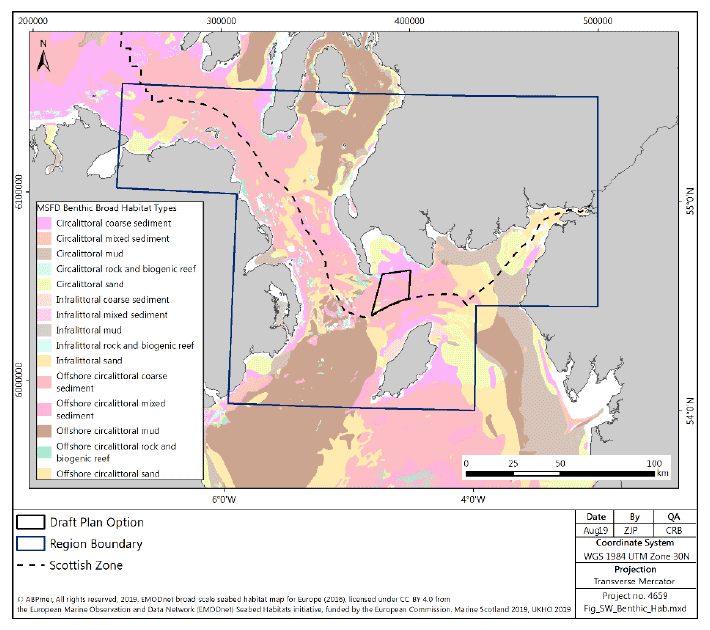
Fish
3.4.10 The fish community in the South West region is varied, although population sizes are generally lower than within the West region. Several species are commercially-important and are discussed above under Fishing in Section 3.3.
3.4.11 There are a number of sightings of basking shark within the South West region (Figure 89), a number of which overlap with SW1, in addition to known populations of other shark and skate species, including porbeagle sharks and spiny dogfish.
3.4.12 The North Channel is a likely migration route for anadromous fish (Figure 44 above in Section 2.3 shows the approximate routes, although should not be used to infer "safe" zones). Migratory fish, including shad species and sea lamprey are protected through the SAC network in the South West region, specifically within the Solway Firth.
3.4.13 The South West region is an important spawning ground for fish species including sole, plaice, sandeel, whiting, anglerfish, cod and herring. Whilst there are a lack of data available to show available spawning sites for elasmobranch species, there are many known nursery ground areas in the area, which overlap the SW1 site, including tope, thornback ray, spotted ray, with high-intensity nursery grounds for spurdog and neighbouring common skate nursery grounds.[173]
Figure 89 South West region: basking shark sightings distribution
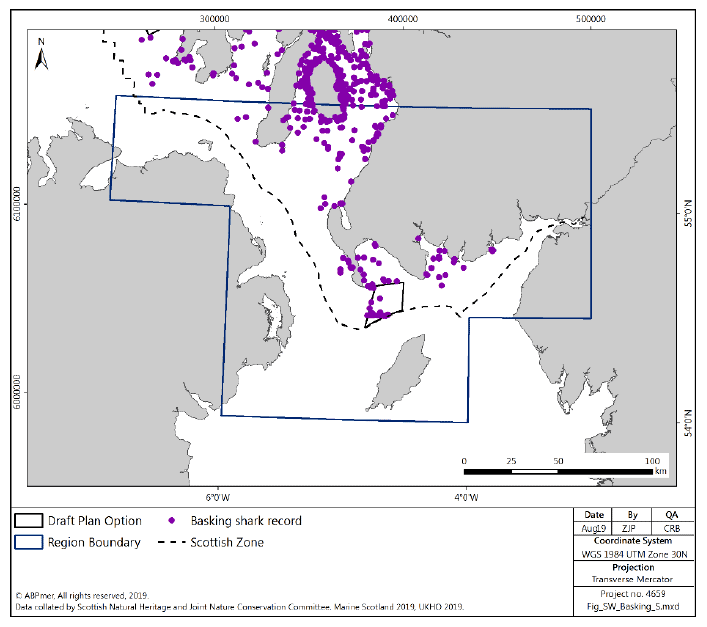
Marine Mammals
3.4.14 There are known to be populations of marine mammals in the South West region, including harbour seals, grey seals, harbour porpoise and short beaked common dolphin.
3.4.15 The populations of both grey and harbour seals within the South West region are comparatively low in comparison to the West region, as reflected in the low at sea usage of the area by both species (Figure 91 and Figure 92) and the scarcity of haulout sites, with small sites in the Solway Firth and to the south east of the Mull of Kintyre (Figure 90). Identified haulout sites (Figure 90) largely do not overlap with the one DPO identified, however one small area neighbours the northerly edge of the DPO. A relatively low level of grey seal at-sea usage was identified within SW1, however, higher levels were identified within the neighbouring area. Relatively low levels of harbour seal at-sea usage were identified around SW1. There are no areas protected for otter in the South West region, however there is potential for their presence in coastal and riverine environments within the region.
Figure 90 South West region: seal haulout sites and grey seal pupping sites
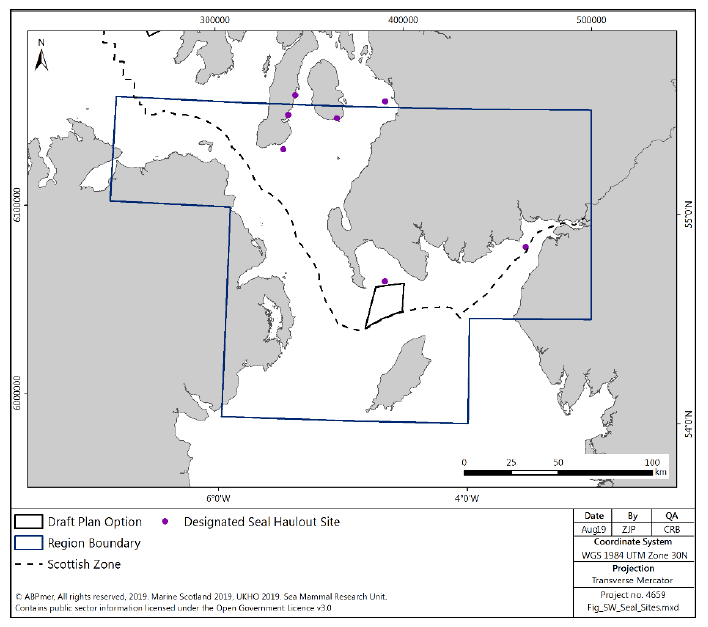
Figure 91 South West region: grey seal at sea usage
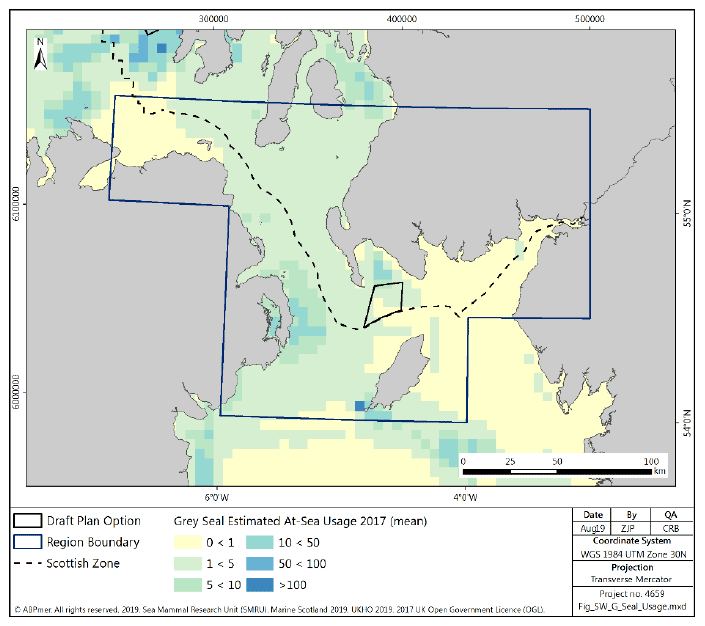
Figure 92 South West region: harbour seal at sea usage
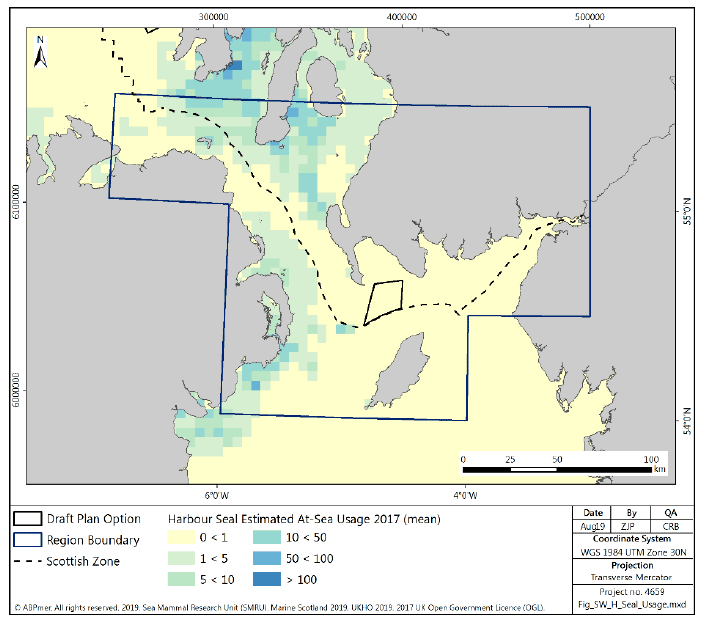
Birds
3.4.16 The importance of the South West region to birds is demonstrated in the designation of two SPAs, and two further proposed SPAs in the region. There is a large SPA already designated within the Solway Firth, with the pSPA proposed to extend it further. The SPAs are designated for a range of both breeding and non-breeding seabird and waterfowl assemblages. At both of the designated sites the overarching assemblages are assessed as Favourable Maintained, however individual species are identified as unfavourable or declining.
3.4.17 Figure 93 maps the total records of seabirds in the marine environment in the South West region. The data has not been corrected for effort, however it shows that there are areas of moderate usage to the south and south-east of the Mull of Kintyre, with comparatively lower usage in the Solway Firth. There are a number of coastal areas within the South West region identified as either Important Bird Areas (IBA) or RSPB reserves in the South West region, particularly in the inner Solway Firth and around Loch Ryan. SW1 overlaps with moderately high levels of records of birds per cell (Figure 93). There are no identified bird areas or RSPB reserves overlapping SW1 but there are sites that neighbour the DPO, such as the Mull of Galloway RSPB reserve.
3.4.18 In addition to the seabird activity discussed above, there are a number of terrestrial birds which are likely to transit through the South West region, including corncrake which migrate to important population centres on the Outer Hebrides and whooper swan which migrate up the west coast.
Figure 93 South West region: ESAS records per 0.1 degree cell
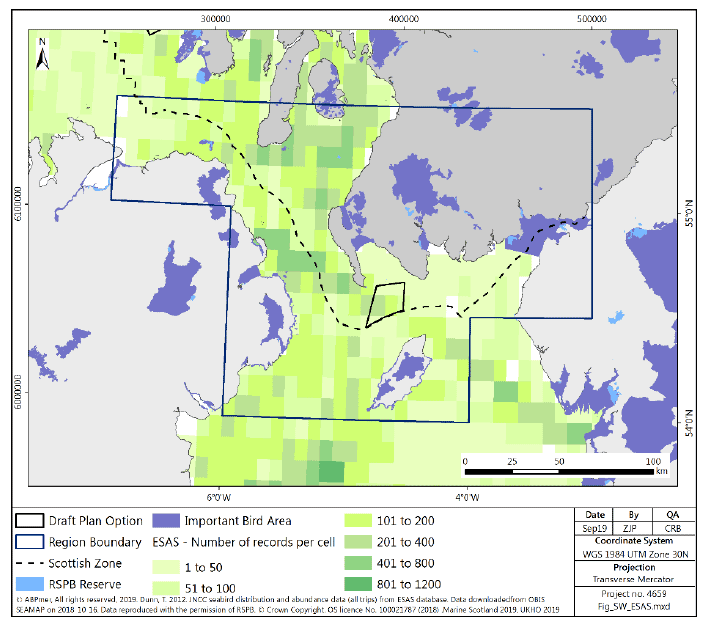
Cultural Heritage
3.4.19 There are no Historic MPAs or scheduled monuments designated in the marine environment in the South West region. However, there are a number of wrecks within the region, of which the remains of one is protected (the surviving elements of a Mulberry harbour).
3.4.20 Within the South West region, there are areas, specifically around the edges of the Solway Firth, which are examples of marine palaeolandscapes (landscapes which have become submerged following occupation by hominids). There is therefore potential for submerged archaeological remains within these areas (Figure 94).
Figure 94 South West region: historic land area
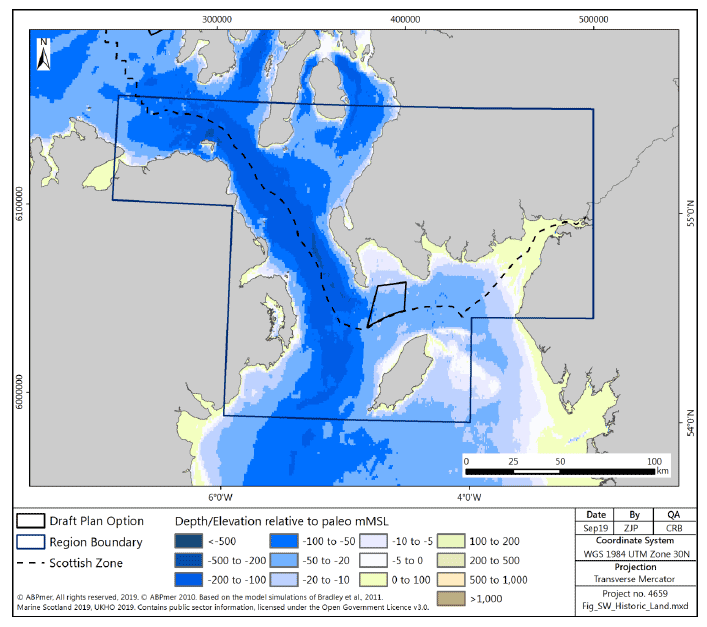
Landscape / Seascape
3.4.21 A character assessment has been undertaken on the Solway Coast Area of Outstanding Natural Beauty (AONB), which identifies the open seas and skies as integral to the experience of the area. It further identifies pressures from offshore wind which may reduce the value of seascapes from the AONB.[174]
3.4.22 There are three National Scenic Areas in the South West region, all on the northern edge of the Solway Firth (Figure 95). Key characteristics include the contrast between the small scale intimacy of the landscape with the open character of the sandflats and the meeting of land, sea and sky.[175]
3.4.23 The low population density on the west coast of Scotland means that the majority of the coastline in the South West region, with the exception of areas around the port of Stranraer and Girvan, can be considered to be isolated. Scott et al.[176] identifies that the seascapes are of medium to large scale, with open sweeping views that would potentially be affected if development were to occur. The coastlines assessed by Scott et al. within the South West region are assessed as of medium (Rhins of Galloway and South Arran / South Ayrshire / South East Kintyre), medium to high (Outer Solway) or high (Inner Solway Firth) sensitivity.[177]
3.4.24 There is no identified overlap between SW1 and National Scenic Areas (Figure 95), however development in SW1 is likely to be visible from the Rhins of Galloway and Outer Solway seascape units.
Figure 95 South West region: National Scenic Areas
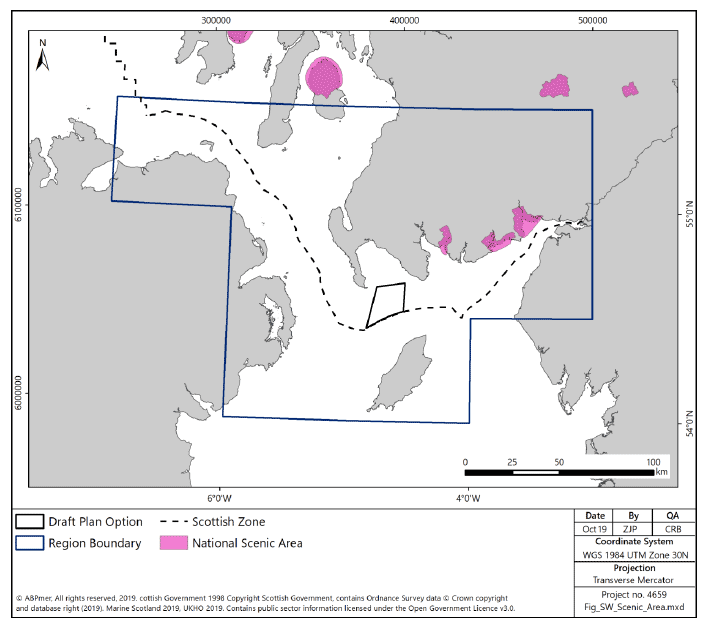
3.5 Planning Issues
3.5.1 There are three local authorities with coastal interests within the South West region. These are:
- Argyll and Bute,
- South Ayrshire, and
- Dumfries and Galloway.
3.5.2 In addition, to the south of the Solway Firth, the English county of Cumbria has coastal interests facing into the Solway Firth and which could be impacted by development in the region.
3.5.3 Argyll and Bute Council has identified the potential to develop locations within its area to support offshore development, specifically identifying supporting development in Campbeltown as part of its renewables energy action plan.[178] The islands of Coll and Tiree, and Islay, the closest of the Inner Hebrides to the DPOs are all the under the jurisdiction of Argyll and Bute Council.
3.5.4 South Ayrshire Council has not stated a position on offshore wind, noting that it is beyond the jurisdiction of the local planning process. However, in comments on marine planning documentation South Ayrshire council has noted the significance of landscape and seascape to the local economy and welcomes the opportunity to comment on any future offshore proposals.[179] However, SW1 does not overlap with the council's remit.
3.5.5 Dumfries and Galloway Council has undertaken a Wind-Farm land Capacity Study[180] which identifies the potential for offshore wind development. It notes that any development within 5km of the coastal edge is likely to have significant impacts on coastal character and on views, but that detailed assessment of the impact of wind farm development will be required on a case by case basis. Specifically, The Mull of Galloway, Wigtown Bay and Inner Solway seascape units were concluded to have a high sensitivity to offshore wind farm development and the Council has recommended resisting offshore development within enclosed bays, close to shore or sited within a seascape context with a notably wild, elemental quality where it would result in significant landscape and visual impacts. The northwest corner of SW1 currently lies within 5km of the southerly edge of the Mull of Galloway.
Contact
Email: drew.milne@gov.scot
There is a problem
Thanks for your feedback